
In the huge sea of investment books, finding the ones that give lasting wisdom and useful tips can be tough. This article is like a guide, helping readers discover some of the best books for investing. From old classics to new hits, these books teach important investment lessons, giving readers a lot of knowledge to understand the complex world of financial markets.
1. “The Intelligent Investor” by Benjamin Graham
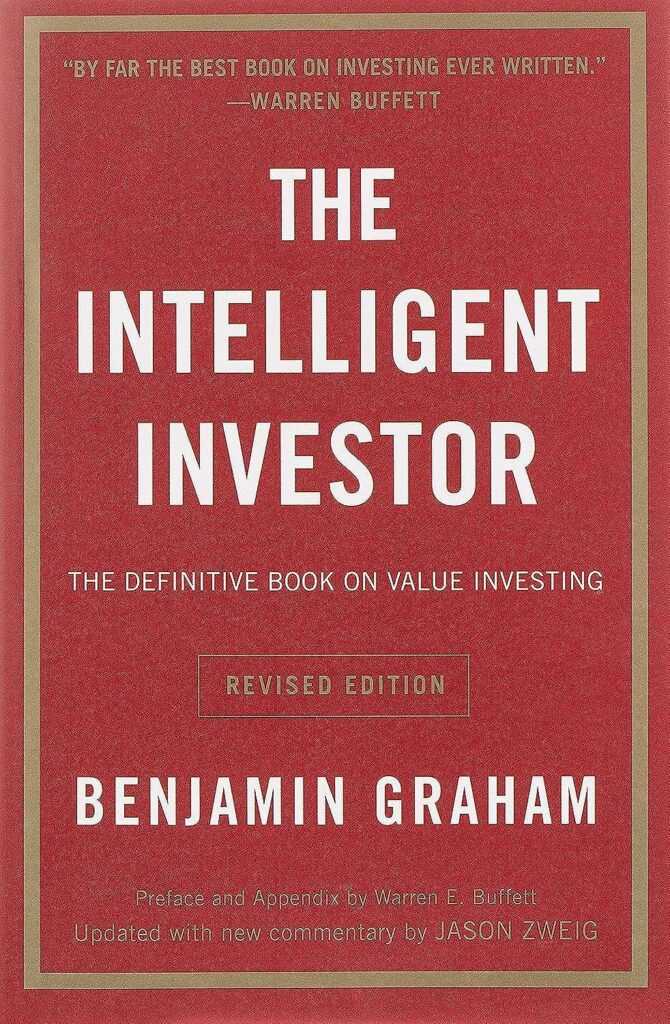
Description:
“The Intelligent Investor” is not just a book; it’s a manifesto that lays the groundwork for a rational and disciplined approach to investing. Benjamin Graham, widely hailed as the father of value investing, distills his decades of experience and profound insights into a comprehensive guide that advocates for a thoughtful, long-term approach to the stock market.
Graham’s writing is clear, accessible, and devoid of the jargon that often plagues financial literature. The book is structured to cater to a broad audience, from novice investors to seasoned professionals, making it a timeless resource for anyone seeking to bolster their understanding of intelligent investing.
Key Takeaways:
- Margin of Safety:
- Graham introduces the concept of a “margin of safety,” emphasizing the importance of purchasing assets at a significant discount to their intrinsic value. This principle acts as a protective cushion against unforeseen market fluctuations.
- Mr. Market Analogy:
- The famous “Mr. Market” analogy encourages investors to view the stock market as a manic-depressive partner whose moods swing without rhyme or reason. Graham’s advice is to take advantage of Mr. Market’s irrationality rather than being swayed by it.
- Difference Between Investment and Speculation:
- Graham draws a clear line between investment and speculation. Investment involves a thorough analysis of fundamentals and a focus on long-term value, while speculation is driven by short-term market trends and lacks a solid foundation.
- Defensive vs. Enterprising Investors:
- Graham categorizes investors into two types—the defensive investor and the enterprising investor. The former is more conservative, favoring a passive approach through index funds, while the latter is willing to engage in active investing with a more hands-on approach.
- Diversification and Portfolio Management:
- The book provides insights into the importance of diversification, risk management, and constructing a well-balanced portfolio. Graham advocates for a systematic approach to investing that aligns with an individual’s risk tolerance and financial goals.
Why You Should Read It:
- Timeless Principles:
- “The Intelligent Investor” stands as a timeless guide that remains relevant irrespective of market conditions. Graham’s principles offer a solid foundation for navigating both bull and bear markets, providing enduring wisdom for investors.
- Foundation of Value Investing:
- For those seeking to understand the bedrock of value investing, Graham’s work is essential reading. The book lays the groundwork for patient, long-term investing, and the mitigation of risk through a margin of safety.
- Risk Mitigation:
- Graham’s emphasis on a margin of safety and the avoidance of speculative behavior provides a roadmap for risk mitigation. Investors looking to preserve capital and navigate the uncertainties of the market will find Graham’s insights invaluable.
- Long-Term Perspective:
- In an era marked by short-termism, “The Intelligent Investor” encourages a long-term perspective. Graham’s teachings foster a disciplined and patient approach that is conducive to sustainable wealth creation over time.
- Adaptability to Individual Circumstances:
- Graham recognizes that investors have different temperaments and goals. The book provides a flexible framework that can be adapted to individual circumstances, making it accessible to a wide range of investors with varying risk appetites and financial objectives.
2. “A Random Walk Down Wall Street” by Burton Malkiel
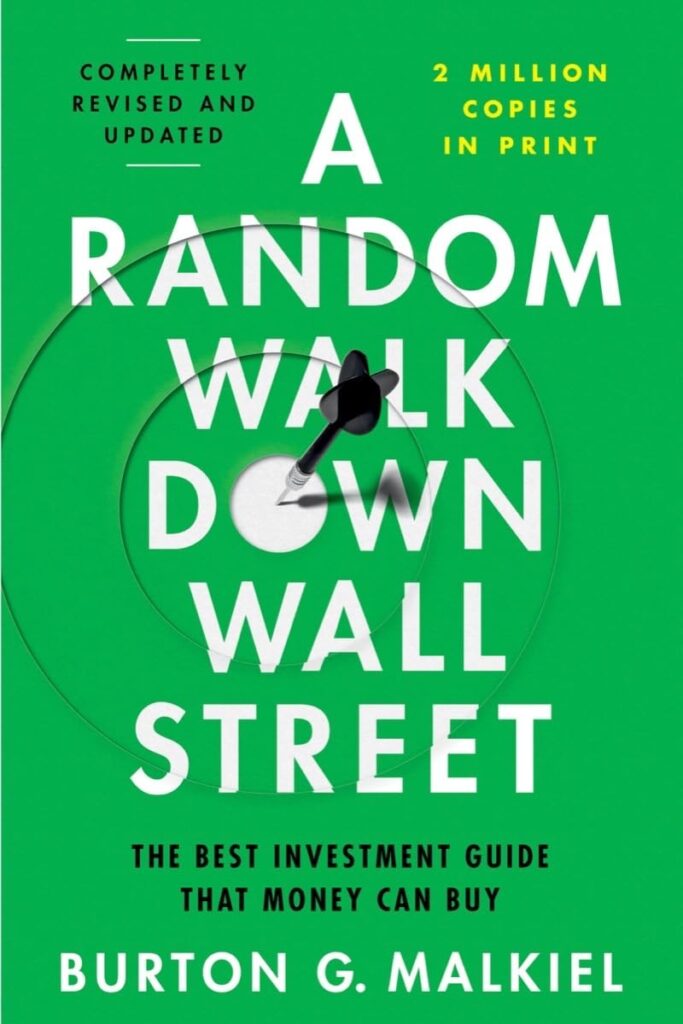
Description:
“A Random Walk Down Wall Street” is not your typical investment book; it’s a strategic guide that takes readers on a journey through the diverse landscape of investment strategies. Burton Malkiel, a Princeton economist, presents a thorough examination of both traditional and alternative investment approaches, weaving together insights on market efficiency, portfolio management, and behavioral finance.
Malkiel’s writing style is accessible, making complex financial concepts digestible for a broad readership. The book caters to investors ranging from beginners seeking an introduction to financial markets to seasoned professionals looking to refine their strategies in the ever-evolving world of investing.
Key Takeaways:
- Efficient Market Hypothesis (EMH):
- Malkiel explores the Efficient Market Hypothesis, suggesting that asset prices reflect all available information. He challenges the notion of consistently outperforming the market through stock picking and market timing.
- Asset Allocation and Diversification:
- The book emphasizes the importance of asset allocation and diversification in constructing a well-balanced portfolio. Malkiel advocates for a strategic mix of asset classes to manage risk and optimize returns.
- Behavioral Finance Insights:
- Malkiel delves into behavioral finance, exploring how psychological biases can impact investment decisions. Understanding investor behavior is crucial for navigating the emotional highs and lows of the market.
- Passive Investing and Index Funds:
- Malkiel is a proponent of passive investing and advocates for the use of low-cost index funds. He argues that, in many cases, passive strategies outperform active ones over the long term.
- Technical and Fundamental Analysis Critique:
- The book critically examines both technical and fundamental analysis, highlighting their limitations and challenges. Malkiel encourages readers to approach these methods with a healthy dose of skepticism.
Why You Should Read It:
- Comprehensive Market Overview:
- For readers seeking a comprehensive overview of various investment strategies, “A Random Walk Down Wall Street” offers a well-rounded exploration. Malkiel covers everything from traditional stock picking to modern concepts like cryptocurrencies.
- Efficiency and Passive Investing Insights:
- Malkiel’s insights into market efficiency and the benefits of passive investing are especially relevant in an era where index funds and ETFs have gained widespread popularity. Understanding these concepts is essential for building a solid investment foundation.
- Behavioral Finance Understanding:
- Behavioral finance is a key aspect of Malkiel’s analysis. For investors looking to understand the psychological factors that influence market behavior, this book provides valuable insights that can aid in making more informed and rational decisions.
- Practical Advice for Investors:
- The book offers practical advice for investors at different stages of their journey. Whether you are a DIY investor or someone who relies on financial advisors, Malkiel’s guidance provides actionable strategies for optimizing your investment approach.
- Market Evolution Considerations:
- Given Malkiel’s commitment to regularly updating the book, readers benefit from insights that consider the evolving nature of financial markets. This makes “A
3. “Common Stocks and Uncommon Profits” by Philip Fisher
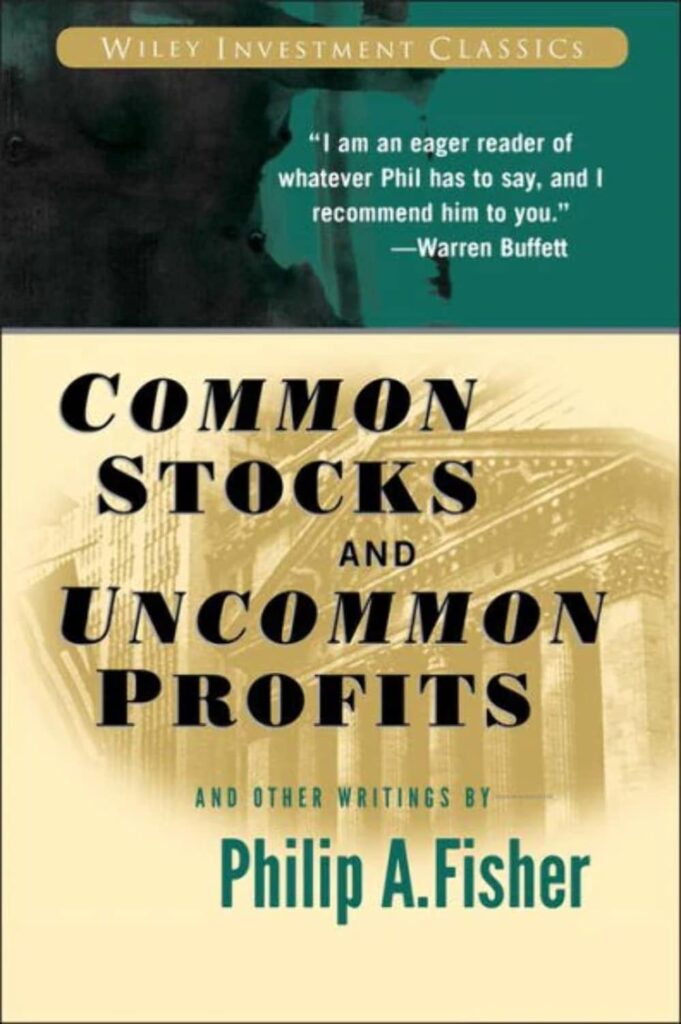
Description:
“Common Stocks and Uncommon Profits” is not just a book; it’s a profound examination of Fisher’s approach to investing in stocks. Written with clarity and depth, Fisher shares his philosophy, distilling decades of experience as a successful investor into a comprehensive guide. The book is structured to provide a holistic view of Fisher’s principles, covering everything from qualitative analysis to the art of understanding businesses.
Fisher’s writing is accessible yet profound, making complex investment concepts understandable for a diverse readership. The book caters to investors at various levels, from those new to the stock market to experienced professionals seeking to deepen their understanding of fundamental analysis.
Key Takeaways:
- Quality Investing:
- Fisher emphasizes the importance of investing in high-quality companies with strong growth potential. He provides a framework for identifying businesses with enduring competitive advantages and potential for long-term success.
- Scuttlebutt Method:
- Fisher introduces the “scuttlebutt” method, encouraging investors to gather information through firsthand research and industry contacts. This qualitative approach aims to provide a deeper understanding of a company’s operations and prospects.
- Management Evaluation:
- The book delves into the critical aspect of evaluating a company’s management. Fisher outlines key attributes of effective management, emphasizing the importance of leadership in a company’s success.
- Long-Term Perspective:
- Fisher advocates for a long-term investment perspective. He emphasizes the significance of holding onto quality stocks through market fluctuations, allowing the compounding of returns over time.
- Margin of Safety:
- While not explicitly stated, Fisher’s emphasis on understanding a company thoroughly serves as a form of creating a margin of safety. By investing in businesses with strong fundamentals, investors can mitigate the risk of permanent loss.
Why You Should Read It:
- Fundamental Analysis Mastery:
- For investors looking to master the art of fundamental analysis, “Common Stocks and Uncommon Profits” is an indispensable resource. Fisher’s insights into assessing the qualitative aspects of businesses provide a foundation for effective stock selection.
- Quality Investing Principles:
- Fisher’s focus on quality investing aligns with the principles of seeking companies with enduring competitive advantages. Readers gain a deeper understanding of what makes a company a worthwhile long-term investment.
- Scuttlebutt Method Application:
- The “scuttlebutt” method introduced by Fisher offers a practical approach to conducting thorough research. Investors can learn how to gather valuable information from various sources to inform their investment decisions.
- Management Evaluation Criteria:
- Understanding the significance of management in a company’s success is a key takeaway from the book. Fisher’s criteria for evaluating management provide a practical framework for investors assessing leadership quality.
- Long-Term Wealth Creation:
- Fisher’s advocacy for a long-term perspective aligns with the philosophy of patient investing. The book offers insights into how investors can cultivate wealth over time by selecting and holding onto quality stocks.
4. “One Up On Wall Street” by Peter Lynch
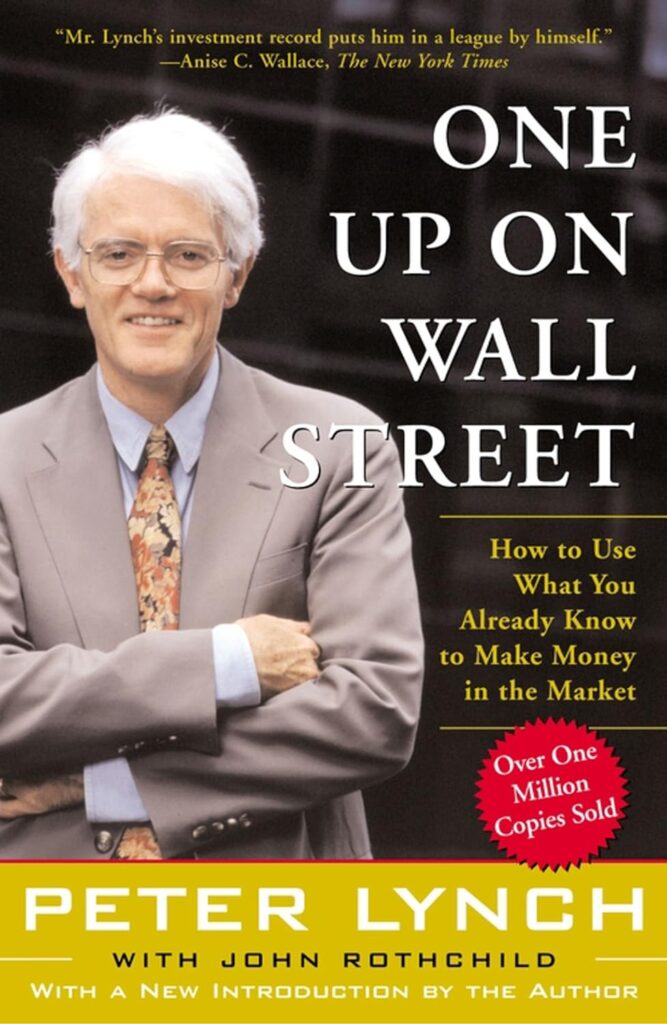
Description:
“One Up On Wall Street” is not just a book; it’s a captivating narrative that takes readers on a journey through Peter Lynch’s remarkable career as the manager of the Fidelity Magellan Fund. Lynch distills his investment philosophy into a comprehensive guide that is both educational and entertaining. The book is structured to provide a blend of practical advice, real-world examples, and a behind-the-scenes look at Lynch’s successful investment strategies.
Lynch’s writing style is accessible and peppered with anecdotes, making complex investment concepts relatable for readers at various levels of financial literacy. The book caters to a broad audience, from novices seeking an introduction to the stock market to seasoned investors looking for practical insights from one of the most successful fund managers in history.
Key Takeaways:
- Invest in What You Know:
- Lynch advocates for the importance of investing in familiar and understandable businesses. He encourages readers to leverage their everyday experiences and observations to identify potential investment opportunities.
- Long-Term Perspective:
- The book underscores the significance of adopting a long-term perspective in investing. Lynch provides examples of successful investments that resulted from patient holding through market fluctuations.
- Categorizing Stocks:
- Lynch introduces the concept of categorizing stocks, such as slow growers, stalwarts, and fast growers. Understanding the characteristics of different types of stocks helps investors tailor their strategies to match their goals and risk tolerance.
- Contrarian Investing:
- Lynch explores the idea of contrarian investing, wherein investors can capitalize on market misconceptions and undervalued stocks. This approach involves going against the crowd and identifying opportunities that others may overlook.
- The 10-Bagger:
- Lynch coined the term “10-bagger” to describe stocks that increase tenfold in value. He discusses the potential for finding these multi-bagger opportunities and how they can significantly contribute to investment success.
Why You Should Read It:
- Practical Wisdom from a Pro:
- “One Up On Wall Street” offers practical wisdom from Peter Lynch, a proven master in the field. Lynch’s straightforward advice and relatable examples make the book an invaluable resource for investors at all levels of experience.
- Investing in Everyday Life:
- Lynch’s emphasis on investing in what you know and observe in everyday life makes the book accessible to a wide audience. Readers can apply these principles to identify investment opportunities in their own spheres of familiarity.
- Lessons from Real-World Success:
- The book is enriched with real-world examples from Lynch’s tenure at the Fidelity Magellan Fund. Lynch shares stories of both successes and failures, providing readers with tangible lessons drawn from his experiences.
- Long-Term Wealth Creation:
- Lynch’s advocacy for a long-term perspective aligns with the philosophy of cultivating wealth over time. The book offers insights into how investors can benefit from compounding returns by holding onto successful investments.
- Contrarian Thinking Insights:
- Lynch’s exploration of contrarian investing provides a counterintuitive perspective that challenges conventional wisdom. Investors looking to diversify their strategies and identify overlooked opportunities can find valuable insights in this section.
5. “Security Analysis” by Benjamin Graham
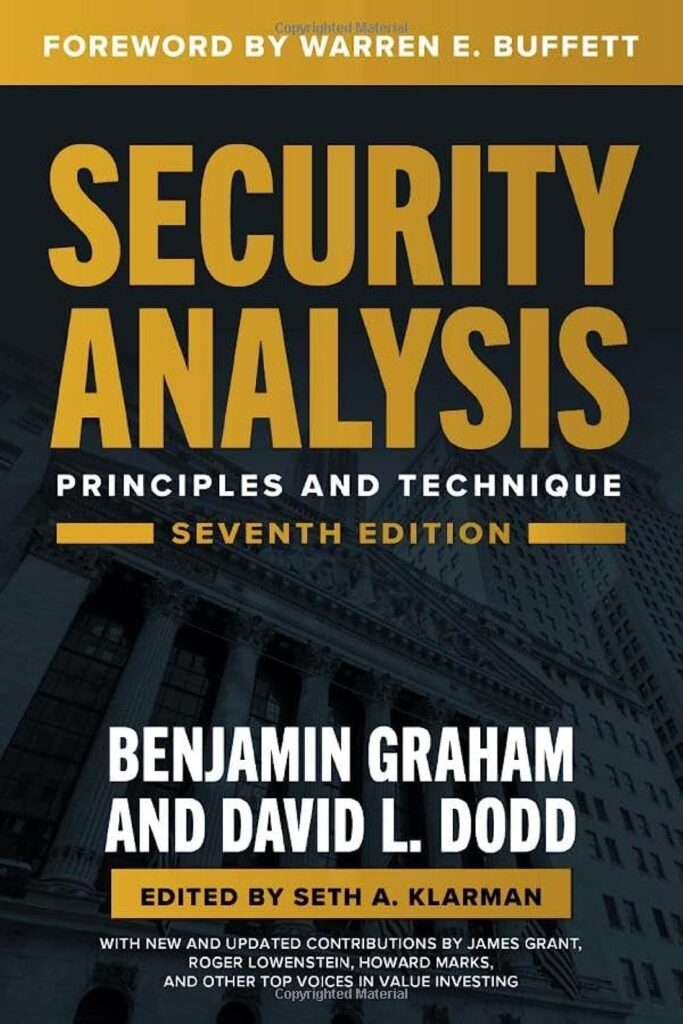
Description:
“Security Analysis” is not just a book; it’s a magnum opus that lays the foundation for fundamental analysis—the bedrock of prudent investing. Benjamin Graham, widely regarded as the father of value investing, and David Dodd, his collaborator, provide a systematic and rigorous approach to evaluating securities. The book is structured to cover a broad spectrum of investment instruments, from stocks and bonds to convertible securities, providing readers with a comprehensive toolkit for analyzing financial assets.
Graham and Dodd’s writing is thorough, methodical, and rooted in a commitment to rigorous analysis. While the book caters to a sophisticated audience, the authors strive to make complex financial concepts accessible to a diverse readership. “Security Analysis” is designed to be a guide for both the seasoned professional and the diligent novice seeking to understand the principles that underpin successful investment decisions.
Key Takeaways:
- Value Investing Principles:
- Graham and Dodd introduce the concept of value investing, emphasizing the importance of buying securities at a significant discount to their intrinsic value. This foundational principle forms the basis for intelligent and disciplined investing.
- Margin of Safety:
- The authors stress the importance of a margin of safety, advocating for purchasing securities with a built-in cushion to protect against market fluctuations and unforeseen risks.
- Earnings and Dividend Analysis:
- The book provides detailed insights into analyzing a company’s earnings and dividends. Graham and Dodd guide readers through the process of assessing a company’s financial health and the sustainability of its dividends.
- Bond Analysis and Credit Risk:
- In-depth coverage of bond analysis, including a focus on credit risk, distinguishes “Security Analysis.” The authors provide a framework for evaluating the creditworthiness of issuers and the risks associated with fixed-income investments.
- Market Fluctuations and Psychological Factors:
- Graham and Dodd explore the impact of market fluctuations and the psychological factors that influence investment decisions. They provide a disciplined approach to navigating market volatility and avoiding emotional pitfalls.
Why You Should Read It:
- Foundational Principles of Value Investing:
- For investors seeking a deep understanding of the foundational principles of value investing, “Security Analysis” is an essential read. Graham and Dodd’s insights have influenced generations of successful investors, including Warren Buffett.
- Comprehensive Toolkit for Analysis:
- The book offers a comprehensive toolkit for analyzing a wide range of securities. Whether you are interested in stocks, bonds, or other financial instruments, “Security Analysis” provides a systematic approach that is applicable across diverse investment scenarios.
- Risk Mitigation through Rigorous Analysis:
- Graham and Dodd’s emphasis on rigorous analysis and the margin of safety provides a roadmap for risk mitigation. Investors looking to protect their capital and make informed decisions in the face of uncertainty will find valuable guidance in this book.
- Timeless Wisdom for Prudent Investing:
- “Security Analysis” is not confined to a specific era or market condition. Its principles offer timeless wisdom that remains relevant in both bull and bear markets, making it a valuable resource for investors navigating various economic climates.
- Influence on Modern Financial Thought:
- The book has played a pivotal role in shaping modern financial thought. Understanding the principles outlined by Graham and Dodd provides a historical perspective on the evolution of investment strategies and practices.
6. “The Essays of Warren Buffett” by Warren Buffett (edited by Lawrence A. Cunningham)
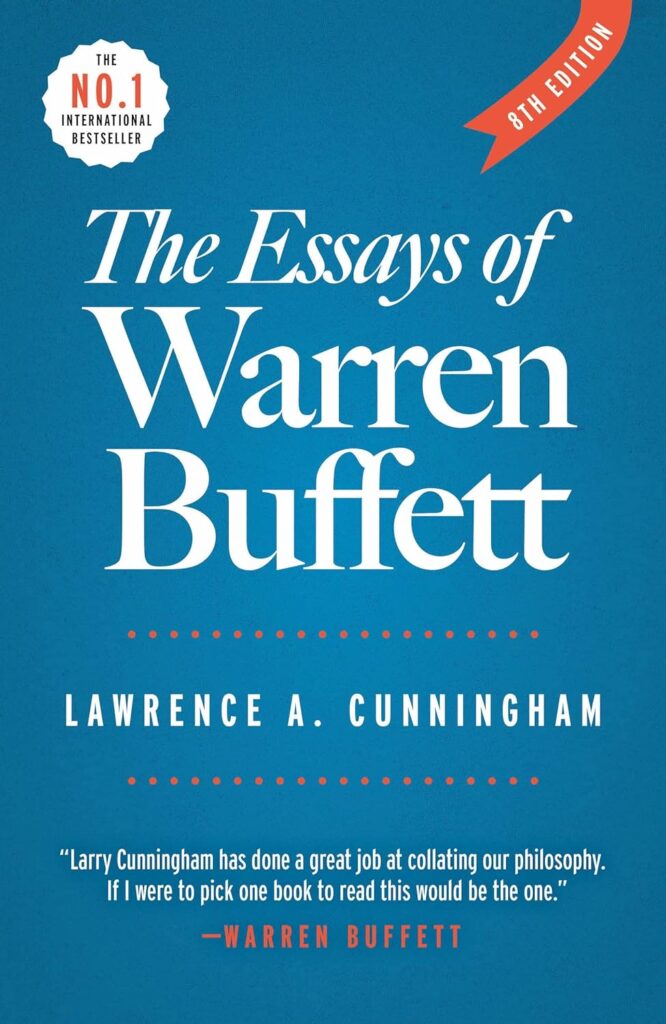
Description:
“The Essays of Warren Buffett” is more than a book; it’s a compilation of Buffett’s annual letters to Berkshire Hathaway shareholders, providing a comprehensive overview of his investment philosophy, business acumen, and timeless principles. Lawrence A. Cunningham has meticulously curated these letters, organizing them by theme and distilling Buffett’s vast knowledge into a coherent narrative.
Buffett’s writing is clear, candid, and infused with his signature wit. The book covers a wide range of topics, from specific investment strategies and market insights to broader principles of business and life. This compilation caters to a diverse audience, making it accessible to both seasoned investors and those new to Buffett’s investment philosophy.
Key Takeaways:
- Long-Term Value Investing:
- Buffett’s commitment to long-term value investing is a recurring theme throughout the essays. He emphasizes the importance of patience, discipline, and a focus on the intrinsic value of businesses.
- Economic Principles and Market Behavior:
- The essays provide valuable insights into Buffett’s understanding of economic principles and market behavior. He shares his thoughts on market efficiency, the impact of inflation, and the cyclical nature of economic trends.
- Circle of Competence:
- Buffett introduces the concept of the “circle of competence,” urging investors to focus on businesses and industries within their expertise. This principle underscores the importance of knowing one’s limitations in the investment process.
- Risk and Margin of Safety:
- Buffett’s approach to risk management and the concept of a margin of safety are central themes. He discusses the importance of avoiding permanent loss of capital and making investments with a built-in buffer against adverse market conditions.
- Management and Corporate Governance:
- The essays offer insights into Buffett’s views on effective management and corporate governance. He emphasizes the importance of trustworthy and capable leadership in the companies Berkshire Hathaway invests in.
Why You Should Read It:
- Direct Insights from Warren Buffett:
- “The Essays of Warren Buffett” offers readers direct access to the thoughts and insights of Warren Buffett. It’s an opportunity to learn from one of the most successful investors in history and understand his approach to investing and business.
- Timeless Investment Principles:
- The principles outlined in the essays are timeless and applicable across different market conditions. Buffett’s focus on fundamentals, long-term value, and risk management provides a solid foundation for investors navigating various economic environments.
- Business and Life Wisdom:
- Beyond investments, the essays provide wisdom on business, ethics, and life. Buffett’s commentary on business practices, ethical considerations, and the importance of reputation adds depth to the book, making it a holistic guide.
- Organized and Accessible Format:
- Lawrence A. Cunningham has organized the essays thematically, making the content accessible and digestible. Readers can explore specific topics of interest or read the collection in its entirety for a comprehensive understanding.
- Historical Perspective on Markets:
- The essays span several decades, offering a historical perspective on markets, economic trends, and the evolution of Buffett’s thinking. This context enhances the educational value of the book for investors interested in market history.
Conclusion
Each of these books is a treasure chest of knowledge, offering different views on investing that suit various tastes and styles. From Graham’s timeless advice to Lynch’s relatable tips and Greenblatt’s methodical approach, these books together offer a complete education in investing. Whether you are new to investing or have been doing it for years, reading these books can deepen your understanding and help you succeed financially. Remember, the best investment you can make is in learning.



